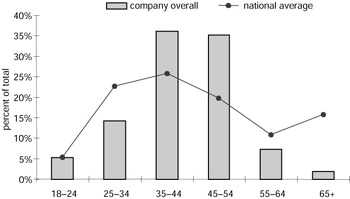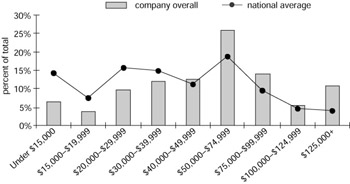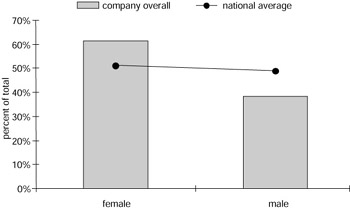Chapter 14: Profile Marketing
|
Overview
For some time, creating customer profiles by appending data from outside sources to a database of customers and prospects has been a thriving business. The basis for this industry is the U.S. Bureau of the Census, which gathers data from every household in America every 10 years, the last time being in 2000. For most people, the census collects only a minimum amount of data: name, address, age, gender, and ethnicity. However, for 2 households out of 14, the census uses the “long form,” which asks many questions about income, value of home, type of plumbing, occupation, and so on—over 200 pieces of data in all. These data are arranged for sale to businesses that are interested. Before providing this information to the business community, the Census Bureau scrambles the data by averaging the answers from the 2 households that filled out the long form and attributing these data to all 14 households in the group. Because of this, you cannot find out Arthur Hughes’s actual income or home value from the census data. What you get appended to Arthur Hughes’s record is the average of the data given by the 2 households out of 14 in the area in which Arthur lives.
This isn’t a bad estimate because as America has evolved, most people live in subdivisions in which the houses are all of similar value. As a result, the incomes of the residents of each group of 14 houses are likely to be similar, as are their ages, number of children, and so on. Only a small percentage of Americans today live in diverse neighborhoods in which poor and rich or old and young live side by side.
To the census information, some large data companies, such as Equifax or Trans Union, add financial data derived from credit flows so that they can estimate a household’s actual income and spending habits. State driver’s license and vehicle registration information is used to determine a person’s actual age and the type of car he or she drives. Catalogers’ data files are used to determine responsiveness to direct-mail offers. Most communities have developed new mover files—databases of people who have just moved in. The U.S. Postal Service provides the National Change of Address (NCOA) system, which corrects addresses of households and businesses. By putting all this information together, it is possible to create a pretty accurate profile of any household or individual if you know the household address.
Profiles are used to create customer and prospect marketing segments. You can divide your database into such groups as
-
Teenagers
-
Young marrieds
-
Families with small children
-
Single women
-
Families with college-age children
-
Empty nesters
-
Seniors
-
College students
Once you have done this, you can check the national average for each category against your own customer database. You can get a picture of the type of person who buys your product and the type who does not. When you know this, you can greatly reduce your marketing costs by trying to reach only the most likely households instead of every household.
What can profiles tell you? Here are some sample profiling results in which a company compared its customers to the national average. To begin with, Figure 14-1 gives a profile by age range. It shows that this company’s customers are clustered in the 35–54 age range, with the percentage of customers in this age range being much higher than the national average. Seniors are certainly not avid consumers of this company’s products.

Figure 14-1: Profile by Age Range
These numbers were derived from appended data that reflect the age of the head of the household. The company also asked its customers what their actual age was. The results were quite different, as shown in Figure 14-2. Here the company’s customers actually were quite young—between 13 and 24. While Figure 14-1 gave the age of the head of the household, most of the company’s customers were children in the household. Conclusion: If you want to know the real facts, ask your customers directly. Appended data do not tell the whole story.

Figure 14-2: Actual Age Range of Customers
What is the income range of your customers? Figure 14-3 gives the results from the same company, using appended head of household data. What can we learn from this graph? The consumers of this company’s products live in households in which the income is close to the national average. Poor people do not buy the products. Those with incomes over $50,000 clearly do.

Figure 14-3: Income Ranges
In terms of gender, the company’s products appeal more to women than to men, as Figure 14-4 shows. Nationwide, women make up about 51 percent of the population. But 62 percent of the consumers of this company’s products are women.

Figure 14-4: Profile by Gender
|
EAN: 2147483647
Pages: 226
- Option 1: Inter-Provider VPN Using Back-to-Back VRF Method
- Command Reference
- Any Transport over MPLS (AToM)
- MPLS QoS Implementation
- Case Study 2: Implementing Multi-VRF CE, VRF Selection Using Source IP Address, VRF Selection Using Policy-Based Routing, NAT and HSRP Support in MPLS VPN, and Multicast VPN Support over Multi-VRF CE